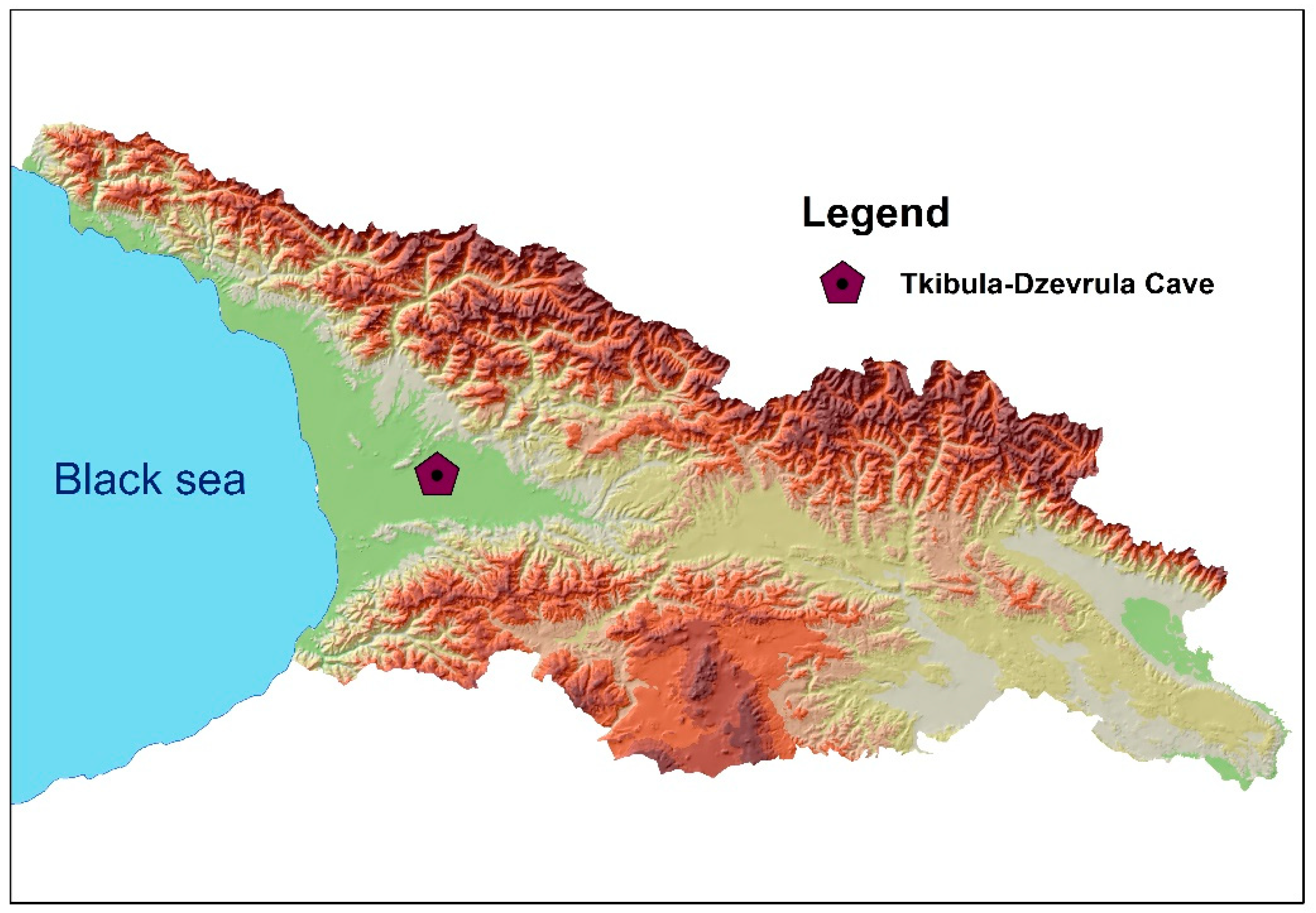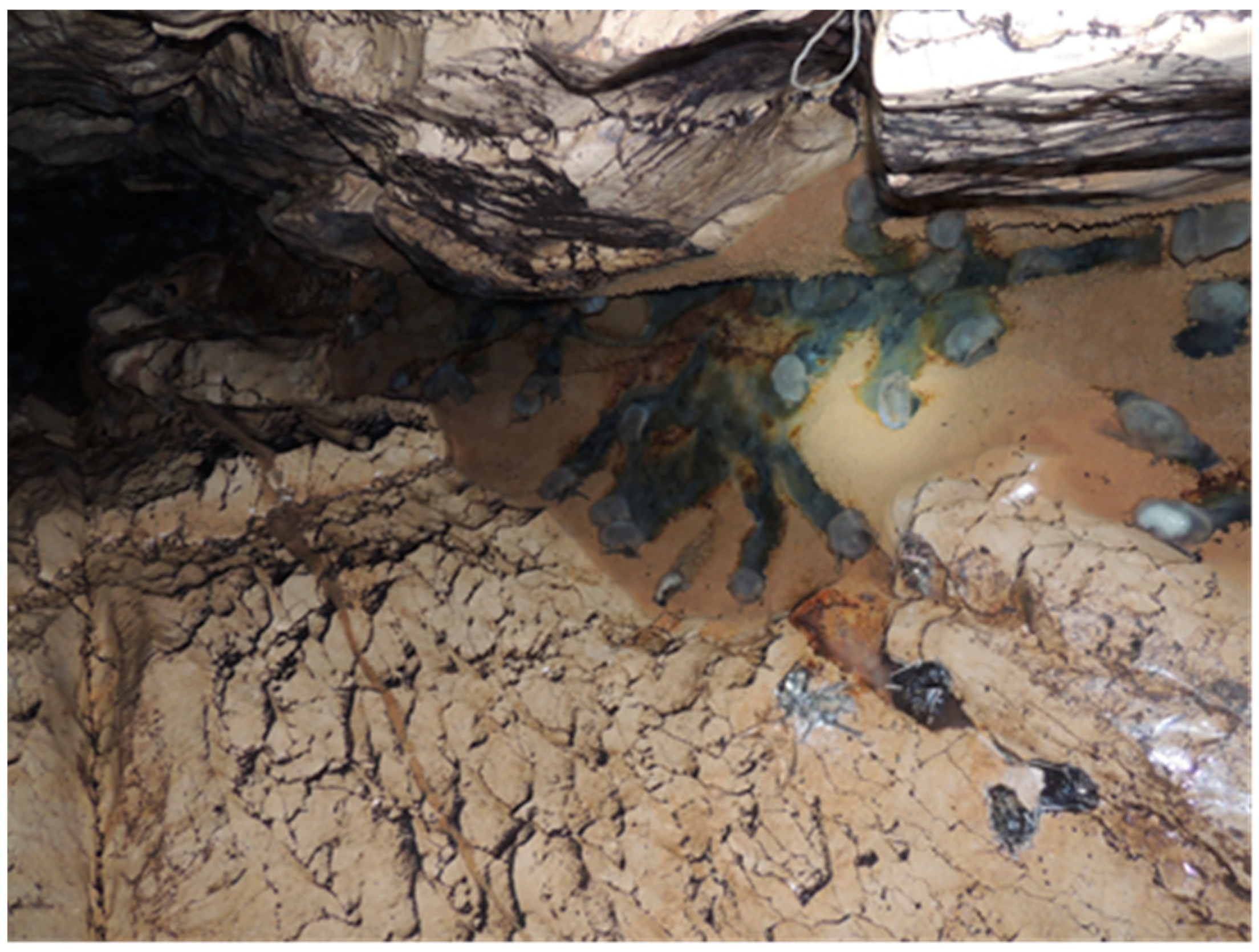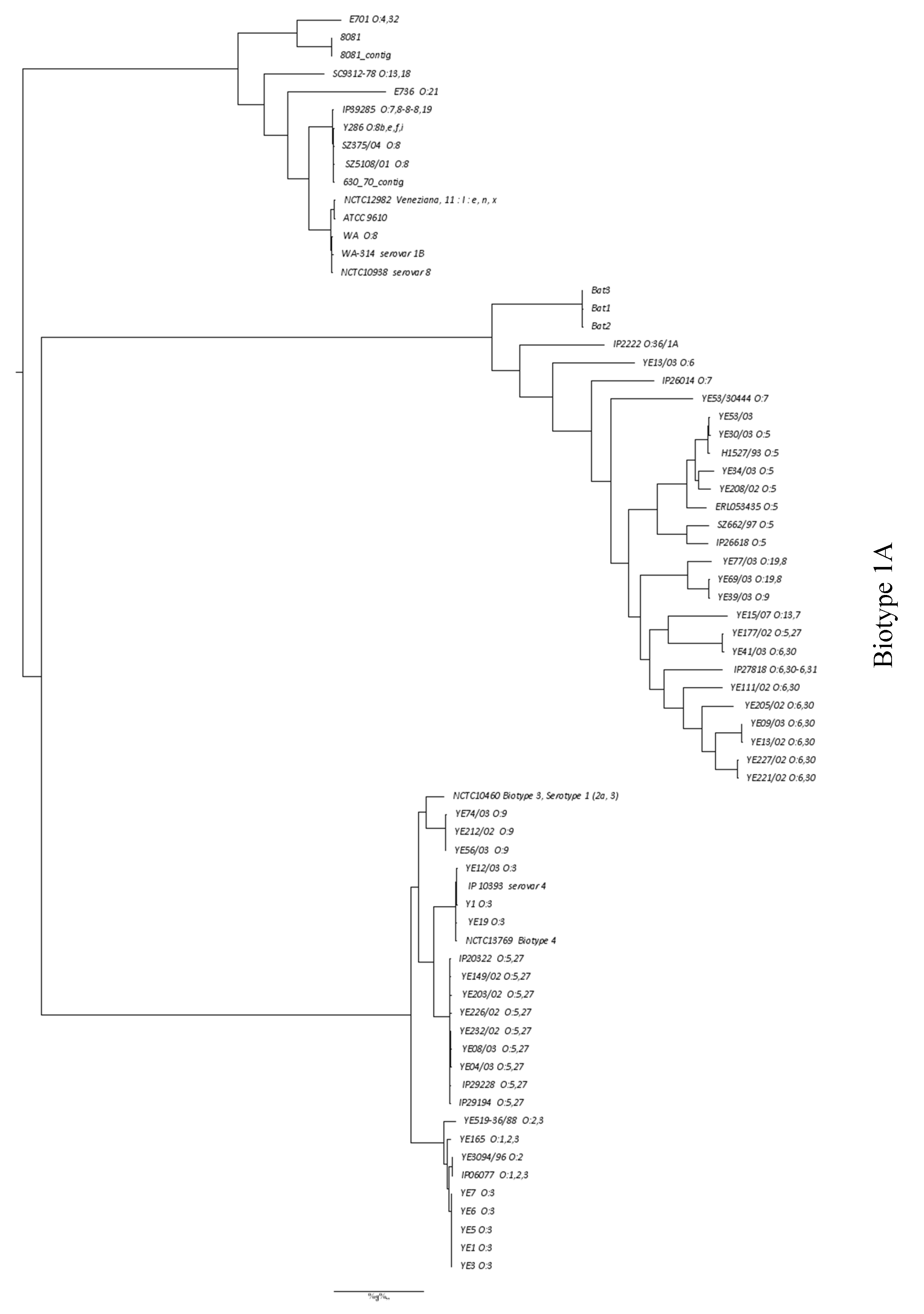Identification of a Novel Yersinia enterocolitica Strain from Bats in Association with a Bat Die-Off That Occurred in Georgia (Caucasus)
Abstract
1. Introduction
2. Materials and Methods
2.1. Study Site and Sample Collection
2.2. Bacteriology
2.3. Genomic DNA Preparation and Sequencing
2.4. Plasmid Screening
2.5. Sequence Analysis
2.6. Phylogenetic Analysis
3. Results
3.1. Die-Off of Bats
3.2. Identification of Bacteria in Dead Bats
3.3. Phenotypical Characterization of Y. entercolitica Strains Isolated from Bats
3.4. Genome Sequences of Y. entercolitica Strains Isolated from Bats
3.5. Phylogeny of Y. entercolitica Strains Isolated from Bats
4. Discussion
Supplementary Materials
Author Contributions
Funding
Acknowledgments
Conflicts of Interest
References
- Hayman, D.T.S. Bat tolerance to viral infections. Nat. Microbiol. 2019, 4, 728–729. [Google Scholar] [CrossRef] [PubMed]
- Beltz, L.A. Bats and Human Health: Ebola, SARS, Rabies and Beyond; Wiley-Blackwell: Hoboken, NJ, USA, 2018; p. 416. [Google Scholar] [CrossRef]
- Mühldorfer, K.; Speck, S.; Kurth, A.; Lesnik, R.; Freuling, C.; Müller, T.; Kramer-Schadt, S.; Wibbelt, G. Diseases and causes of death in European bats: Dynamics in disease susceptibility and infection rates. PLoS ONE 2011, 6, e29773. [Google Scholar] [CrossRef] [PubMed]
- Mühldorfer, K. Bats and bacterial pathogens: A review. Zoon. Publ. Health. 2013, 60, 93–103. [Google Scholar] [CrossRef] [PubMed]
- Wren, B.W. The yersiniae—A model genus to study the rapid evolution of bacterial pathogens. Nat. Rev. Microbiol. 2003, 1, 55–64. [Google Scholar] [CrossRef] [PubMed]
- Bancerz-Kisiel, A.; Szweda, W. Yersiniosis—A zoonotic foodborne disease of relevance to public health. Ann. Agric. Environ. Med. 2015, 22, 397–402. [Google Scholar] [CrossRef] [PubMed]
- Bottone, E.J. Yersinia enterocolitica: The charisma continues. Clin. Microbiol. Rev. 1997, 10, 257–276. [Google Scholar] [CrossRef]
- Muhldorfer, K.; Wibbelt, G.; Haensel, J.; Riehm, J.; Speck, S. Yersinia species isolated from bats, Germany. Emerg. Infect. Dis. 2010, 16, 578–580. [Google Scholar] [CrossRef]
- Tatashidze, Z.; Tsikarishvili, K.; Jishkariani, J. Cadaster of Karstic Caves of Georgia; Proceedings, New Series; Vakhusthi Bagrationi Institute of Geography Press: Tbilisi, GA, USA, 2009; Volume 82, 666p. [Google Scholar]
- Bai, Y.; Urushadze, L.; Osikowicz, L.; McKee, C.; Kuzmin, I.; Kandaurov, A.; Babuadze, G.; Natradze, I.; Imnadze, P.; Kosoy, M. Molecular survey of bacterial zoonotic agents in bats from the country of Georgia (Caucasus). PLoS ONE 2017, 12, e0171175. [Google Scholar] [CrossRef]
- Kado, C.I.; Liu, S.T. Rapid procedure for detection and isolation of large and small plasmids. J. Bacteriol. 1981, 145, 1365–1373. [Google Scholar] [CrossRef]
- Zhou, Z.; Alikhan, N.-F.; Mohamed, K.; Fan, Y.; Achtman, M.; The Agama Study Group. The EnteroBase user’s guide, with case studies on Salmonella transmissions, Yersinia pestis phylogeny, and Escherichia core genomic diversity. Genome Res. 2020, 30, 138–152. [Google Scholar] [CrossRef]
- Childs-Sanford, S.E.; Kollias, G.V.; Abou-Madi, N.; McDonough, P.L.; Garner, M.M.; Mohammed, H.O. Yersinia pseudotuberculosis in a closed colony of Egyptian fruit bats (Rousettus aegyptiacus). J. Zoo Wildl. Med. 2009, 40, 8–14. [Google Scholar] [CrossRef]
- Nakamura, S.; Settai, S.; Hayashidani, H.; Urabe, T.; Namai, S.; Une, Y. Outbreak of yersiniosis in Egyptian rousette bats (Rousettus aegyptiacus) caused by Yersinia pseudotuberculosis serotype 4b. J. Comp. Pathol. 2013, 148, 410–413. [Google Scholar] [CrossRef] [PubMed]
- Tennant, S.M.; Grant, T.H.; Robins-Browne, R.M. Pathogenicity of Yersinia enterocolitica biotype 1A. FEMS Immunol. Med. Microbiol. 2003, 38, 127–137. [Google Scholar] [CrossRef]
- Batzilla, J.; Heesemann, J.; Rakin, A. The pathogenic potential of Yersinia enterocolitica 1A. Int. J. Med. Microbiol. 2011, 301, 556–561. [Google Scholar] [CrossRef]
- Platt-Samoraj, A.; Żmudzki, J.; Pajdak-Czaus, J.; Szczerba-Turek, A.; Bancerz-Kisiel, A.; Procajło, Z.; Łabuć, S.; Szweda, W. The Prevalence of Yersinia enterocolitica and Yersinia pseudotuberculosis in Small Wild Rodents in Poland. Vector Borne Zoonotic Dis. 2020. [Google Scholar] [CrossRef] [PubMed]
- Bhagat, N.; Virdi, J.S. Distribution of virulence-associated genes in Yersinia enterocolitica biovar1A correlates with clonal groups and not the source of isolation. FEMS Microbiol. Lett. 2007, 266, 177–183. [Google Scholar] [CrossRef] [PubMed]
- Ebringer, R.; Colthorpe, D.; Burden, G.; Hindley, C.; Ebringer, A. Yersinia Enterocolitica Biotype I, diarrhoea and episodes of HLA B27 related ocular and rheumatic inflammatory disease in South-East England. Scand. J. Rrheumatol. 1982, 11, 171–176. [Google Scholar] [CrossRef]
- Grant, T.; Bennett-Wood, V.; Robins-Browne, R.M. Identification of virulence-associated characteristics in clinical isolates of Yersinia enterocolitica lacking classical virulence markers. Infect. Immun. 1998, 66, 1113–1120. [Google Scholar] [CrossRef]
- Morris, J.G.; Prado, V.; Ferreccio, C.; Robins-Browne, R.M.; Bordun, A.M.; Cayazzo, M.; Kay, B.A.; Levine, M.M. Yersinia enterocolitica isolated from two cohorts of young children in Santiago, Chile: Incidence of and lack of correlation between illness and proposed virulence factors. J. Clin. Microbiol. 1991, 29, 2784–2788. [Google Scholar] [CrossRef]
- Tennant, S.M.; Skinner, N.A.; Joe, A.; Robins-Browne, R.M. Homologues of insecticidal toxin complex genes in Yersinia enterocolitica biotype 1A and their contribution to virulence. Inf. Immun. 2005, 73, 6860–6867. [Google Scholar] [CrossRef]
- Burnens, A.P.; Frey, A.; Nicolet, J. Association between clinical presentation, biogroups and virulence attributes of Yersinia enterocolitica strains in human diarrhoeal disease. Epidemiol. Infect. 1996, 116, 27–34. [Google Scholar] [CrossRef] [PubMed][Green Version]



| Tests | Abbrev. | Bat 1 | Bat 2 | Bat 3 |
|---|---|---|---|---|
| Test for beta-galactosidase enzyme | ONPG | pos | pos | neg |
| Decarboxylation by arginine dihydrolase | ADH | neg | neg | neg |
| Decarboxylation by lysine decarboxylase | LDC | neg | neg | neg |
| Decarboxylation by ornithine decarboxylase | ODC | pos | pos | neg |
| Utilization of citrate | CIT | neg | neg | neg |
| Production of hydrogen sulfide | H2S | neg | neg | neg |
| Urease test | URE | pos | pos | pos |
| Detection of tryptophan deaminase | TDA | neg | neg | neg |
| Indole test production | IND | pos | pos | pos |
| Voges-Proskauer test | VP | pos | pos | pos |
| Production of gelatinase | GEL | neg | neg | neg |
| Fermentation of glucose | GLU | pos | pos | pos |
| Fermentation of mannose | MAN | pos | pos | pos |
| Fermentation of inositol | INO | pos | pos | pos |
| Fermentation of sorbitol | SOR | pos | pos | pos |
| Fermentation of rhamnose | RHA | neg | neg | neg |
| Fermentation of sucrose | SAC | pos | pos | pos |
| Fermentation of melibiose | MEL | neg | neg | neg |
| Fermentation of amygdalin | AMY | pos | pos | pos |
| Fermentation of arabinose | ARA | pos | pos | pos |
| Genomic Properties | Strain Bat1 | Strain Bat2 | Strain Bat3 |
|---|---|---|---|
| Assembly size (bp) | 4,675,988 | 4,675,119 | 4,676,549 |
| n contigs | 29 | 28 | 56 |
| G + C content | 47.35 | 47.09 | 47.09 |
| Number of protein-coding genes (CDS) | 4220 | 4220 | 4225 |
| CDS (Function assigned) | 2897 | 2897 | 2895 |
| CDS (Hypothetical/putative) | 1323 | 1323 | 1330 |
| Genes | 3107 | 3107 | 3105 |
| Number of tRNAs | 67 | 67 | 65 |
| rRNAs (23 S, 16 S, and 5 S) | 7 | 6 | 6 |
© 2020 by the authors. Licensee MDPI, Basel, Switzerland. This article is an open access article distributed under the terms and conditions of the Creative Commons Attribution (CC BY) license (http://creativecommons.org/licenses/by/4.0/).
Share and Cite
Imnadze, T.; Natradze, I.; Zhgenti, E.; Malania, L.; Abazashvili, N.; Sidamonidze, K.; Khmaladze, E.; Zakalashvili, M.; Imnadze, P.; Arner, R.J.; et al. Identification of a Novel Yersinia enterocolitica Strain from Bats in Association with a Bat Die-Off That Occurred in Georgia (Caucasus). Microorganisms 2020, 8, 1000. https://doi.org/10.3390/microorganisms8071000
Imnadze T, Natradze I, Zhgenti E, Malania L, Abazashvili N, Sidamonidze K, Khmaladze E, Zakalashvili M, Imnadze P, Arner RJ, et al. Identification of a Novel Yersinia enterocolitica Strain from Bats in Association with a Bat Die-Off That Occurred in Georgia (Caucasus). Microorganisms. 2020; 8(7):1000. https://doi.org/10.3390/microorganisms8071000
Chicago/Turabian StyleImnadze, Tata, Ioseb Natradze, Ekaterine Zhgenti, Lile Malania, Natalia Abazashvili, Ketevan Sidamonidze, Ekaterine Khmaladze, Mariam Zakalashvili, Paata Imnadze, Ryan J. Arner, and et al. 2020. "Identification of a Novel Yersinia enterocolitica Strain from Bats in Association with a Bat Die-Off That Occurred in Georgia (Caucasus)" Microorganisms 8, no. 7: 1000. https://doi.org/10.3390/microorganisms8071000
APA StyleImnadze, T., Natradze, I., Zhgenti, E., Malania, L., Abazashvili, N., Sidamonidze, K., Khmaladze, E., Zakalashvili, M., Imnadze, P., Arner, R. J., Motin, V., & Kosoy, M. (2020). Identification of a Novel Yersinia enterocolitica Strain from Bats in Association with a Bat Die-Off That Occurred in Georgia (Caucasus). Microorganisms, 8(7), 1000. https://doi.org/10.3390/microorganisms8071000






